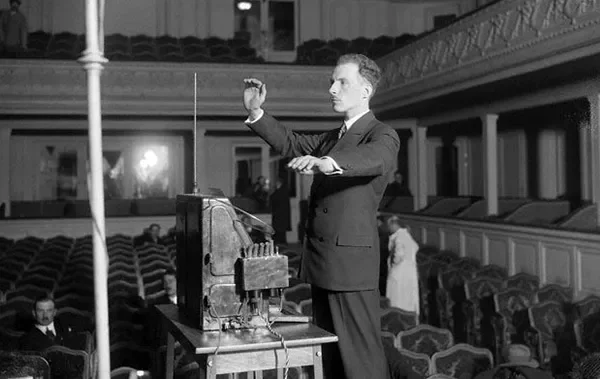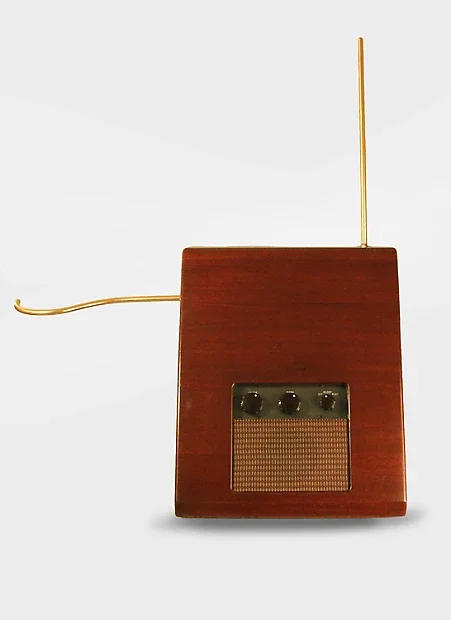Good Vibrations!
Intro
Xan Hughes has dedicated his entire life to a unique musical instrument; played with nothing but the AIR! The theremin traditionally uses just two metal antennas emitting electromagnetic where you can play music controlling pitch and volume wirelessly in the open space between you and said antennas.
The Theremin Is His Gnosis
Hughes discovered the instrument when asking the universe for an instrument that had no frets like a fretless bass but overall bit more melodic. On March 9, 2016 he got his answer. When visiting the Google homepage; he stumbled across a birthday Google Doodle for legendary virtuosa thereminist Clara Rockmore!
The Impossible?
With the freedom of non-existent frets and an uncommon instrument to find an instructor locally, the inspired musician began teaching himself how to play, as it seemed, an impossible musical instrument.
Features & Past Work
His work is featured in recorded material from around the globe! Working with artists from New York City to Japan. Hughes has experience performing his theremin in the studio and live on-stage.
The Mission
X-Ray’s Theremin Museum is the educational branch of Xan Hughes’s mission to help further showcase the theremin such as inventor Leon Theremin did back in 1920s/30s. His traveling collection of theremin artifacts and memorabilia; can be viewed online and in person at events and performances.
The HISTORY of the THEREMIN!
LEON THEREMIN
The Discovery
Around 1919, Soviet-Russian physicist Leon Theremin was tinkering with a device that featured an antenna measuring gases in the air.
Leon had the genius idea to include an audio oscillator to the circuitry. All the sudden, when he put his hand near the antenna; the device’s wailing call changed pitch.
Legend has it, Leon and his colleagues started playing little tunes on the device.
Moving to America
The theremin was later patented in the United States around 1928. Leon then moved to New York City where he would set up his theremin studio on 37th West 54th Street.
During his time in the States, Leon met very gifted virtuoso violinist Clara Rockmore. Unfortunately, Clara had arthritis in his bow hand which limited her ability to perform violin.
A Unique Star Was Born
Leon introduced Clara Rockmore to his invention; where she became the FIRST virtuosa of the theremin. Recording five amazing albums in her life time!
Clara Rockmore inspires thereminists today as her instructional work booklet “Theremin Method” guides players from the source.
For the full digital .PDF of Clara Rockmore’s theremin guide; you can download it from the museum’s archive drive here.
European Thereminvox Demo: Leon Theremin showcasing his instrument in Paris, France. (circa. 1927)
Those super tall almost diamond shaped structures behind Leon Theremin are unique loud speakers from the RCA company!
Clara Rockmore; famous for being the WORLD's FIRST theremin virtuosa!
She developed her technique keeping a very calm “in the zone” type focus.
Leon Theremin & Clara Rockmore
Taken on Clara's 18th Birthday (circa. 1929)
HOW IT WORKS!
The Basics
The theremin usually features a single pitch antenna OR more traditionally; a pitch rod + volume loop combo. As we are solely conductive beings; our body and hands can manipulate the parameters of the theremin due to the capacitance controlled wirelessly in the air.
Functionality
These antennas emit an electromagnetic field; with the volume loop mainly picking up anything interfering above and below vertically. The pitch rod can be interrupted from about any direction.
Some theremin antennas come in different shapes, sizes, and materials. Bob Moog’s Vanguard theremin is one of my favorite examples of super unique antenna designs. It features this volume antenna that’s cut in half somehow; and I even wonder if it would feel different to play.
The Battle Between Interference
Electronics and materials such as metal, WiFi interference, nearby power supplies, LED lights, and/or even a friend walking into your theremin space can sometimes interrupt the quality and outcome of any performance.
Bob Moog’s Vanguard was a late 1950’s vacuum-tube theremin. It featured a single, fixed timbre. This model did not have any tone controls unlike Bob’s later “professional” model.
Bob Moog’s Unique Vanguard Theremin










